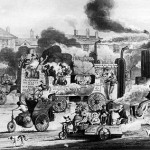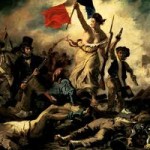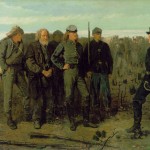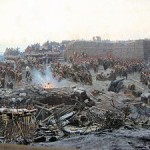Politics
Industrial Revolution Continues
Industrial Revolution Transcript (PDF)
- Trains
- Steamships
- Bicycle
- Increasing urbanization
- Need for a concentrated work force
- Need to be near raw materials
- Need to be near transportation hubs
- Gas lamps for street lighting
- Communication
- Telegraph & telephone
France
- 1804 Napoleon is Emperor
- 1814 Napoleon is ousted
- 1814-1830 The Bourbon Dynasty holds the throne in France
- 1830 — Charles X is overthrown in “The July Revolution’
- 9 Street riots in Paris between 1830-1848 — Second Republic is established
- 1870 Haussmann completes the rebuilding of Paris – optional
- Infected alleyways and centers of epidemics destroyed
- Wider streets — Grand boulevards
- New water and sewage systems
- The poor and working class are evicted to the suburbs
- 1870-71 Franco-Prussian War
Abolitionism
- Europe and America
- Implications for the Caribbean and South America as well
America
Russia
- 1853-56 Crimean War optional – Russia allied with France and Britain against the Ottoman Empire
- Fought on the Crimean peninsula — now part of modern day Ukraine
Germany
Britain
- Ruled by Queen Victoria (and Parliament) from 1837-1901
- The Boer War – optional
Religion
Emancipation of Jewish society in Europe – optional
Artists, musicians, and writers capitalize on the “God granted’ abilities
Religion Still There Transcript (PDF)
Recognition that the more we know, the more we realize there is more that is unfathomable
Romantic era writers capitalize on conflicts within the human mind and heart as well as on our ignorance of things.
The mystical and mysterious is celebrated.
Nature is depicted as evidence of God’s Bounty.
Sciences
Louis Pasteur – optional 1822-95
- French
- The study of micro organisms
- Understanding how disease is spread
- Sterile practices
- Pasteurization of milk
Charles Darwin – optional 1809-82
- English
- On the Origin of Species
- The theory of evolution based on natural selection
Sigmund Freud optional1856-1939
- Born in Moravia, lived in Vienna
- At the turn of the century he begins to publish his theories
- Develops the concepts of psychoanalysis
- Splits the human psyche into the ego, the id and the super ego
Paint Technology – Art Technology Alert!!!! Required reading
Improvements in how paints were stored made painting out of doors much easier
Architecture
It is perfectly acceptable to include architecture in your blog.
Neo Gothic and Baroque Transcript (PDF)
Neo Gothic
- BritishParliament 1836
- Gothic revival was strongest in England
- Meant to evoke the spiritual and ethical values of the Middle ages
Neo Baroque
- Charles Garnier — optional Opera House Paris 1861-1874
- Meant to emulate extreme sumptuousness
Industrial Developments
- Cast Iron
- Steel
- Formed concrete
Crystal Palace —optional built for the Great Exhibition of 1851 in England
Please explore the link for this amazing building that did not withstand the test of time.
- Joseph Paxton — gardener to the Duke of Devonshire
- Prefabricated, modular cast iron frame work
- Supporting over 900,000 square feet of glass
- This model was quickly adapted to railway stations and other large spaces
- Crystal Palace was destroyed
Louis Sullivan optional 1856-1924
American
- Commercial buildings reinforced with steel and formed concrete
- Allowed for building higher
- “Form follows function’
- Buildings should elevate the spirit of those who worked in it
- Wainwright Building
Frédéric-Auguste Bartholdi — Statue of Liberty 1886
French
- Collaborated with Gustave Eiffel
- Over 150 feet tall
- Gift from France to America
Eiffel Tower – Gustave Eiffel
- Built in 1889
- A demonstration of engineering technology
Art Nouveau and Architecture – optional
- A short-lived style
- Influenced by nature
- Decorative features that included curving lines, like plant foliage





